GENETICS FINAL EXAM
1/44
There's no tags or description
Looks like no tags are added yet.
Name | Mastery | Learn | Test | Matching | Spaced |
|---|
No study sessions yet.
45 Terms
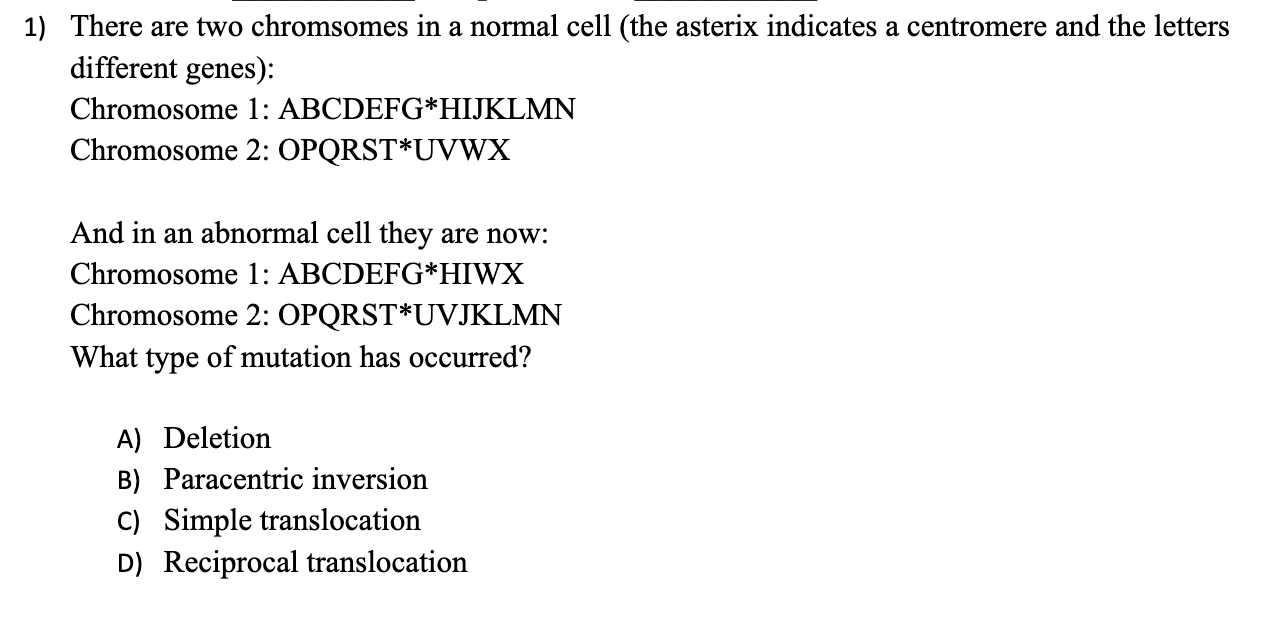
Reciprocal translocation
Two chromosomes swap segments

Heterogamous
Gametes are different size/shape
Hetero=Different

Parental phenotypes
WHY:
In three-gene crosses:
Parental phenotypes (original combo of traits) are the most frequent in the F2 generation.
This is because:
Crossing over doesn’t always happen
And when it does, double crossovers (C) are super rare
Single crossovers (B) are more common than double but still less than parentals

Double crossover
A) Single crossover : Can happen between any two genes → doesn’t tell you order
B) Parental : Tells you the starting combo, but not what's different
C) Double crossover : Only one gene flips = the middle one

56
Step 1: Understand the chromosome number
14 pairs = 28 chromosomes (because diploid = 2n)
So, before DNA replication = 28 chromosomes
= 28 DNA molecules
Step 2: What happens in G₂ phase?
G₂ = right after DNA replication
Each chromosome now has 2 sister chromatids
28 chromosomes × 2 chromatids each = 56 chromatids

Sister chromatids
100% identical
These are exact copies of a single chromosome made during S phase
Formed when DNA replicates → each chromosome is now 2 identical chromatids connected at a centromere

Epistasis can result in multiple altered ratios, not just 9:7
Some examples:
Recessive epistasis → 9:3:4
Dominant epistasis → 12:3:1
Duplicate recessive epistasis → 9:7 ← this is just one of many possibilities
So it’s incorrect to say “always results in a 9:7 ratio”

diploid ; haploid
Somatic cells : Diploid (2n) : Skin, liver, brain, etc.
Germ cells : Haploid (1n) : Sperm & egg cells
Somatic = body cells → full set of chromosomes (from both parents)
Germ = reproductive cells → only half, so they can fuse and make a full set at fertilization

27%
12% + 15% = 27%
3% → Too small — would only be true if the genes were super close
75% → Can’t happen! Recombination frequency can’t go above 50% → at 50% they are unlinked
Any number above 50% = biologically impossible

The genes are assorting independently = ALWAYS the default null hypothesis

Euploidy = "True sets"
The organism has a whole number of complete chromosome sets
Option Euploid or not? Why?
A) Tetraploid✅ Euploid --> 4 full sets (4n)
B) Aneuploid❌ NOT Euploid --> Abnormal single chromosomes (not sets)
C) Triploid✅ Euploid --> 3 full sets (3n)
D) Polyploid✅ Euploid --> General term for >2 sets
E) Diploid✅ Euploid --> Normal 2 sets (2n)

Metaphase of mitosis
In mitosis, individual chromosomes (each made of 2 sister chromatids) line up in the center of the cell → that’s metaphase
So if you see 3 duplicated chromosomes lined up → it means:
It came from a diploid cell (2n = 6)
And it’s in regular metaphase
Also i like to think of it as:
miTOEsis” = mitosis = physical = diploid = body cells
Metaphase = middle → they're lined up like toes
LMFAO

Dominant
Offspring are all green → that means green is dominant, because it shows up even when paired with yellow.

Organized representation of the chromosomes within a cell
A karyotype is literally a picture of all the chromosomes in a cell, arranged in order by size and shape (and by number).
It’s how we visually check:
Chromosome number (ex: 46 in humans)
Sex chromosomes (XX or XY)
Structural abnormalities (extra/missing parts)
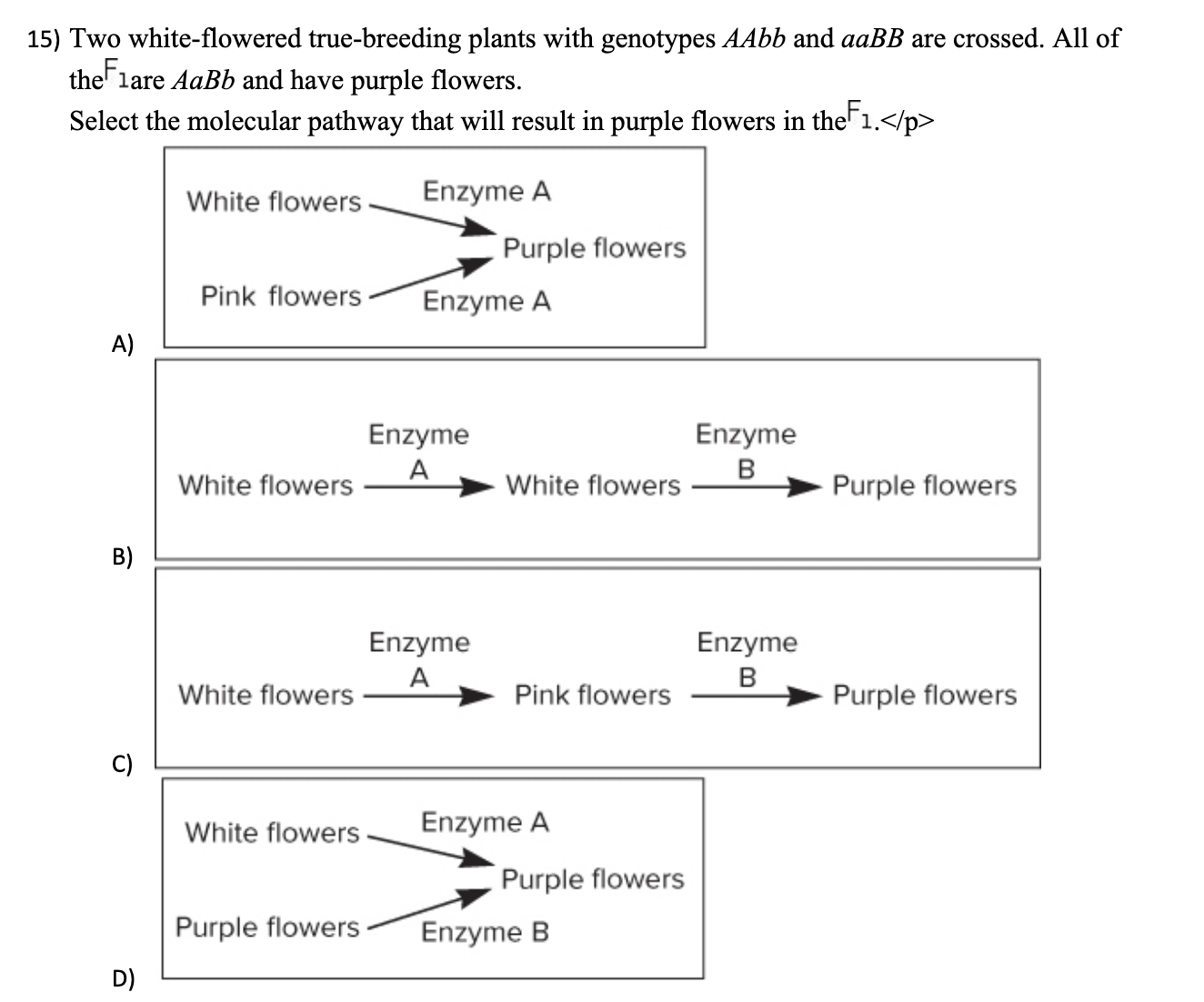
Option C
Parents: AAbb × aaBB → both white flowers
Offspring: AaBb → PURPLE flowers
So BOTH genes (A & B) are needed to make purpl
Parent 1 (AAbb): has Enzyme A ✅ but no Enzyme B ❌ → stops at pink
Parent 2 (aaBB): has Enzyme B ✅ but no Enzyme A ❌ → never leaves white
F1 (AaBb): has both enzymes → full conversion → purple
Option C is the only one that shows:
Enzyme A → Pink
Enzyme B → Purple
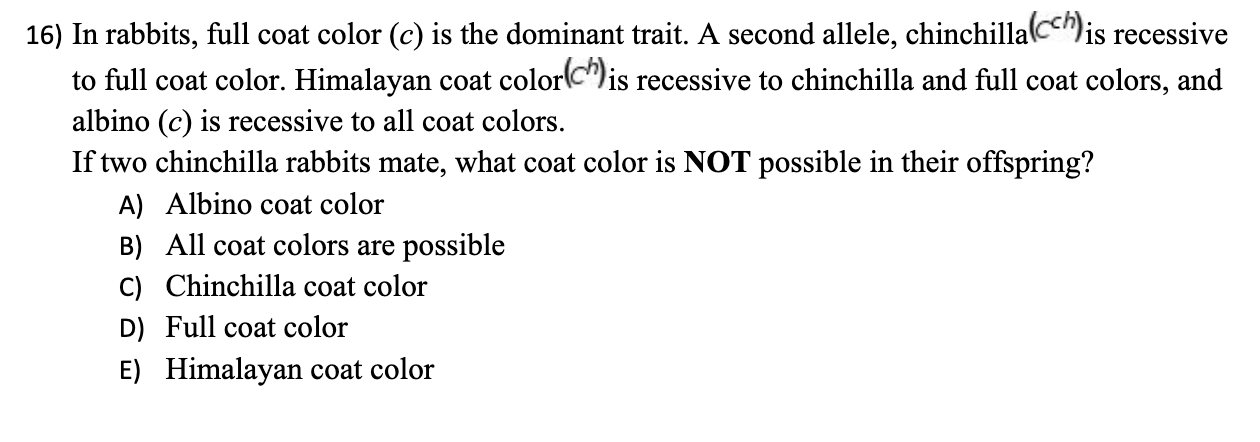
Full Coat Color

Haploid Gametes
In a Punnett square:
The outside = the parental gametes
These are the sperm & egg possibilities.
Each one has 1 allele → meaning they’re haploid (1n)
The inside of the Punnett square = where the gametes meet
→ those are your diploid (2n) offspring
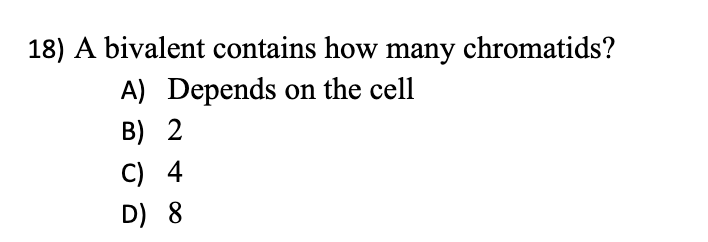
4 chromatids
A bivalent = a pair of homologous chromosomes that are physically paired during meiosis I.
Each chromosome has 2 sister chromatids, so:
1 chromosome = 2 chromatids
2 homologous chromosomes = 4 chromatids total
“Bi-” = 2 chromosomes
Each = 2 chromatids → 2 × 2 = 4 total

Interstitial deletion
A middle chunk (internal piece) is deleted

9:3:3:1

incomplete dominance
When a heterozygote has a phenotype that’s a blend or intermediate between homozygous dominant and homozygous recessive — that’s classic incomplete dominance.
Example:
Red flower (RR) × White flower (rr)
→ Offspring = Pink flower (Rr)
→ That’s incomplete dominance! The heterozygote shows a mix.

15 map units
Map Units = (recombinants/total) x 100 = (30/200) x 100 = 15 map units
What are map units?
1 map unit = 1% recombination
So 15% recombinants = 15 cM apart on chromosome

4; 25
Tetraploid: 4 full sets of chromosomes
Total chromosomes = 100 —> So 100 ÷ 4 = 25 per set

COMPLEMENTATION
What is complementation?
It happens when:
Two mutations are in different genes
Each parent provides the functional version the other lacks
So the offspring has at least one working copy of each gene → wild-type phenotype!
Complementation = complete combo = functional baby
When two broken things make one functional outcome

Wild-type
The wild-type allele is:
The most common allele in a natural population
Usually fully functional
Makes protein in the right amount
Is considered the “normal” version

Temperature-sensitive alleles
Siamese cats have:
Darker fur on the cooler parts of their body (ears, paws, tail)
Lighter fur on warmer parts (torso)
That’s because the pigment-producing enzyme they have is:
Only active in cooler temperatures
So the gene works differently depending on temperature.

Paracentric Inversion:
Inversion that does NOT include the centromere
When crossing over happens within that loop, it can create:
One chromosome with two centromeres (dicentric)
One chromosome with none (acentric)
That's dangerous, and it only happens with paracentric, not pericentric.

D) ½ pink, ½ white
We’re dealing with incomplete dominance, where:
RR = red
rr = white
Rr = pink
So, if you cross:
Pink (Rr) × White (rr)
Offspring:
2 Rr = pink
2 rr = white

Genes that are on the same chromosome are always transmitted together as a unit.
“Always transmitted together” is NOT true.
Why? Because of crossing over!
Even if genes are on the same chromosome, they can be separated if crossing over happens between them

Stern
Curt Stern (1931) gave visual proof of crossing over using Drosophila.
He showed that chromosomal exchange matched the recombinant phenotypes.
It was the first cytological evidence linking chromosomes to gene behavior.
Why its NOT Morgan and Bridges:
- They worked on linkage and inheritance patterns but not direct visual proof

Far Apart
The farther apart two genes are, the greater the chance a crossover will happen between them during meiosis.
That’s because there's more physical space for the enzymes to break and swap DNA segments.
This is the entire basis of genetic mapping!
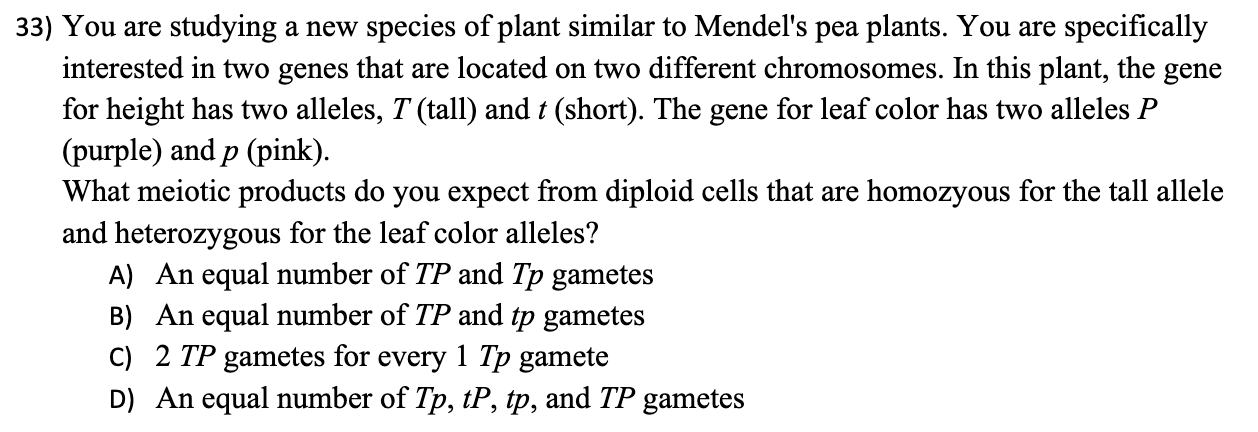
An equal number of TP and Tp gametes
You can only make TP or Tp gametes.
So your answer must show those two — nothing else.

Pleiotropy
One gene → many traits
Pleiotropy = Plenty o' Traits
For example:
The sickle cell gene affects:
Red blood cell shape
Malaria resistance
Blood flow/oxygen issues → All from one gene? That’s pleiotropy.

Locus
A locus = the specific location or “address” of a gene on a chromosome
Two genes that are located on the same chromosome are said to be __________.
Physically linked
Physically linked means:
The genes are on the same chromosome
They are close together (physically near each other)
This makes them more likely to be inherited together
AKA: genetic linkage
Linked = Located Together
"Physically linked" means they’re literally stuck on the same DNA strand
In a dihybrid cross of two heterozygous individuals, you expect a 9:3:3:1 phenotypic ratio in the offspring, but observe a ratio of 9:7. What is the most likely explanation?
Epistatic interaction of the two genes
Epistasis = when one gene masks or interferes with the expression of another gene
This causes changes to the expected Mendelian ratios in a dihybrid cross.
If you expect 9:3:3:1 but get 9:7 → think epistasis (genes interfering)
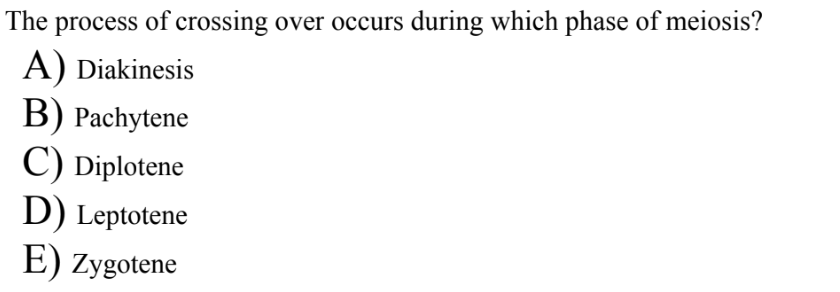
Chiasma
A chiasma (plural = chiasmata) is the X-shaped structure that forms when non-sister chromatids exchange DNA during crossing over.
It literally looks like the letter “X”, which is where the name comes from.
Seen during Diplotene of Prophase I in meiosis when homologous chromosomes are pulling apart but still connected at crossover points.

homozygous recessive for the genes
The purpose of a testcross is to reveal the genotype of the heterozygous individual by analyzing the phenotypes of the offspring.
When you cross with a homozygous recessive, the offspring’s phenotype is directly tied to the alleles they inherited from the heterozygous parent.
This makes it easy to spot recombination events when mapping genes.

B) Easily identifiable traits:
Pea plants have clear-cut, contrasting traits (like tall vs. short, green vs. yellow seeds), which made inheritance patterns easy to observe.C) Ability to self-fertilize:
This allowed Mendel to produce pure lines (true-breeding plants) over generations—super important for controlled crosses.D) Easy to cross-fertilize:
Mendel could also manually cross different plants by transferring pollen—giving him control over parentage and traits.
Map distance is equal to the number of recombinant offspring divided by the total number of
nonrecombinant offspring.
A) true
B) false
False
It's recombinants / total offspring,
not recombinants / nonrecombinants.

incomplete penetrance
But if someone has the allele and does not express the trait phenotypically, that means the trait didn’t “penetrate”.

Prophase → Prometaphase → Metaphase → Anaphase → Telophase
Prophase – Chromosomes condense, spindle forms
Prometaphase – Nuclear envelope breaks down, spindle attaches to kinetochores
Metaphase – Chromosomes align at the metaphase plate
Anaphase – Sister chromatids are pulled apart to opposite poles
Telophase – Nuclear membranes reform, chromosomes decondense
Followed by cytokinesis, which separates the cell.
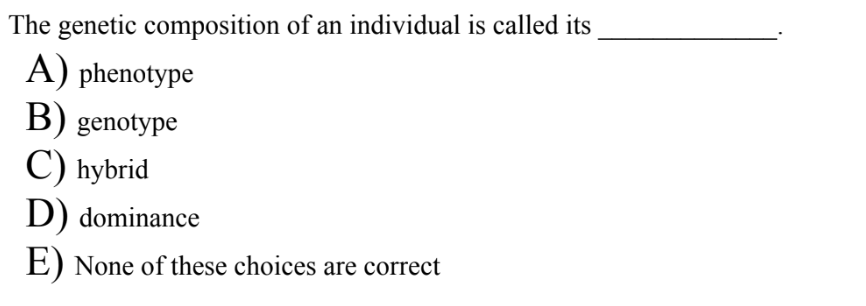
Genotype
So when the question asks for the genetic composition, they’re asking about what alleles the individual has → that’s your genotype.
Mendel's work with single-factor crosses resulted in the development of which of the
following?
A) All of these choices are correct
B) Law of segregation
C) Law of independent assortment
D) Theory of natural selection
E) Law of biological evolution
Law of segregation
Mendel’s single-factor crosses involved tracking one trait at a time, like flower color or seed shape. From these, he discovered that:
Each individual has two alleles for a trait, and these alleles separate during gamete formation.
This is known as the Law of Segregation — your two alleles get separated into different gametes, so each gamete gets just one.